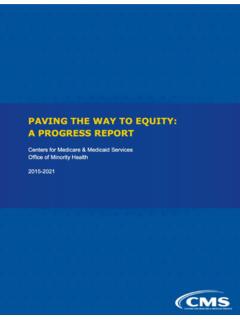Transcription of Health Systems Change - Centers for Disease Control and ...
1 A Guide to Facilitating Health SystemsChange Department of Health anD HUman ServiceS Centers for Disease Control and prevention A Guide to Facilitating Health Systems Change A Guide to Facilitating Health Systems Change | Building Partnerships 2 Contents Division for Heart Disease and Stroke Prevention Mission 4 Acknowledgments 5 Preface 7 Section One: Building Partnerships9 Section Two: Deciding What You Want to Accomplish 29 Section Three: Planning to Make It Happen 39 Section Four: Implementing Your Action Plan 49 Section Five: Monitoring the Progress 87 A Guide to Facilitating Health Systems Change Building Partnerships 3 Mission of the Centers For Disease Control and Prevention Division for Heart Disease and Stroke Prevention To provide public Health leadership to improve cardiovascular Health for all, reduce the burden, and eliminate disparities associated with heart Disease and stroke A Guide to Facilitating Health Systems Change | Building Partnerships 4 Acknowledgments A Guide to Facilitating Health Systems Change was developed by the Centers for Disease Con trol and Prevention, National Center for Chronic Disease Prevention and Health Promotion, Division for Heart Disease and Stroke Prevention Belinda Minta, MPH, Ronald Todd, MSEd, and Jan Jernigan, PhD.
2 Were the lead authors and were assisted by project officers from the Program Development and Services Branch, State Program Services Team States receiving capacity building and basic implementation funding from the division also reviewed this document and provided input A Guide to Facilitating Health Systems Change | Building Partnerships 5 A Guide to Facilitating Health Systems Change | Building Partnerships 6 Preface Overview The purpose of this guide is to help states facilitate changes in Health care Systems to improve prevention and management of heart Disease and stroke and their risk fac tors The guide was developed with the idea that state Health departments can facilitate such changes by involving a diverse group of Health care partners to assess the state of heart Disease and stroke prevention and management, to identify changes that are needed to improve the quality of care.
3 And to determine how best to make those chang es The goal of this guide is to provide advice to state heart Disease and stroke prevention programs in encouraging the adoption of established models to improve the quality of care and outcomes for patients with car diovascular Disease (CVD) or its risk factors Programs should review the entire guide to determine which sections and resources are most appropriate for them, given the current environment for Systems Change within their state This guide includes samples of tools states have developed to assist with program plan ning, implementation, and evaluation activi ties within the Health care system The tools provided at the end of each section can be altered or augmented to meet organizational and partner needs Background In 1998, Congress provided funding for the Centers for Disease Control and Prevention (CDC) to initiate a national, state-based heart Disease and stroke prevention program As of July 2007, CDC funds heart Disease and stroke prevention programs in 33 states and the District of Columbia Many factors increase the risk of developing heart Disease and stroke.
4 Therefore, state-based programs must use strategies that target multiple risk factors in different settings, including Health care, work sites, and communities CDC plays a national leadership role in promoting heart Health and reducing the burden of heart Disease and stroke This leadership involves collaborating with many sectors federal, state, and local governments; voluntary organizations; academic institu tions; faith-based organizations; Health care organizations; work sites and media to achieve the vision of a heart-healthy and stroke-free nation In 2003, CDC convened key public Health partners to develop A Public Health Action Plan to Prevent Heart Disease and Stroke The Action Plan identifies targeted recom mendations and specific steps necessary to reduce the Health and economic toll of heart Disease and stroke The Action Plan interventions to improve risk factor detec tion and Control , emergency care, acute case management, and patient management and rehabilitation will require changes in Health care Systems Role of State Heart Disease and Stroke Prevention Programs According to the Institute of Medicine s report Crossing the Quality Chasm (2001)
5 , The American Health care delivery system is in need of fundamental changes The current system has too many shortcomings, including the gap between evidence-based recommendations and medical practice, limited use of technology, a lack of integra tion among clinical disciplines, and inad equate coordination among clinicians A Guide to Facilitating Health Systems Change | Building Partnerships 7 A transition from short-term treatment of acute conditions to prevention and manage ment of chronic diseases through the use of multidisciplinary teams, decision support tools/evidence-based guidelines, and clinical information Systems is critical to sustaining Systems changes Increased costs, high use of medical services, and Health disparities associated with treating CVD and stroke contribute to the growing realization that Health care services must be efficiently delivered for effective management of chronic diseases Systematic changes are needed to coordinate all aspects of patient care, improve patient self-management, and increase access to care for those at greatest risk State heart Disease and stroke preven tion programs will be challenged to establish Health care partnerships, commit resources, cultivate leadership within the Health care community, and monitor progress once changes are implemented Definition of Health Systems Change A Change in organizational or legislative policies or in environmental supports that encourages and channels improvement(s)
6 In Systems , community, and individual-level Health outcomes Examples of Health Systems Change National and state-based disparities collaboratives that use the chronic care model Standardized emergency medical personnel training Electronic medical records or other clinical information system and decision support tools Section Description This guide is divided into five major sections, each organized by Section Summary, Lessons Learned, Getting Started, and Resources and Tools Section One: Building Partnerships Identifies potential partners and provides insight into organizing, maintaining, and enhancing partnerships Section Two: Deciding What You Want to Accomplish Provides information on possible data sources that may be used to assess the chronic Disease burden and current state of Health care Systems and to map opportu nities for intervention Section Three: Planning to Make It Happen Describes the significance of using data to drive program planning activities.
7 Pro vides a guideline on developing an action plan that outlines priorities, partner respon sibilities, objectives, and timelines Section Four: Implementing Your Action Plan Identifies approaches to consider when putting your plan into action, and highlights the successful components of an implemen tation plan Section Five: Monitoring the Progress Describes methods for monitoring interven tion progress and assessing outcomes A Guide to Facilitating Health Systems Change | Building Partnerships 8 Section One Building Partnerships Section Summary Changing Health care Systems requires a collaborative approach A variety of skills, ideas, and resources are needed to produce meaningful, sustained Systems Change In this section, we describe Potential partners with the assets and resources to facilitate Systems Change Ideas for initiating and sustaining partnerships Lessons learned from states about developing partnerships Potential Partners When states begin working on Systems Change , the best partners to involve are those who have an obvious interest in the issue.
8 Who include Systems Change as a part of their mission, and who have resources to support the effort It is important to have representation from diverse and distinct organizations with experience in initiating and sustaining Systems Change in settings that serve high-risk populations To plan, implement, and evaluate Health Systems strategies and activities, you must first identify and collaborate with stakehold ers internal and external to your organization Partners provide expertise and resources that complement those available within the state Potential partner organizations and institu tions may include employers and employer groups/coalitions, community organizations, professional and voluntary groups, Health providers and Health delivery Systems , and emergency medical services (EMS) The following list of organizations and agencies should be considered as potential partners Many of them probably already participate in your state s heart Disease and stroke prevention efforts as members of your state coalition or advisory council This list is by no means complete Each state is unique and may have other organiza tions, such as chronic Disease programs (e g , Diabetes Prevention and Control Program), medical schools, employee Health benefits departments, and county extension services that can contribute to Systems Change EMERGENCY MEDICAL SERVICE Systems Overview EMS represents the intersection of public Health , public safety, and Health care for prehospital care General EMS components include Emergency medical technicians (EMTs)
9 And paramedics who treat victims at the scene and during transport to hospitals Ground and air ambulance response and transport services 9-1-1 call Centers that dispatch emergency response State EMS offices that license providers and serve a regulatory function EMS physicians who provide oversight via online and offline medical direction EMT schools and training Centers . A Guide to Facilitating Health Systems Change | Building Partnerships 9 Function Every state has an EMS office, which may be associated with the Health department or the public safety arm of the government Most offices are responsible for regulating and licensing EMTs and responders All offices have a director and may include additional staff to address Systems changes EMS coordination often involves a patch work of local provider Systems , which may be public, private, volunteer, or, most often, a combination Public provider locations include fire departments, Health departments, emergency management agencies, and other state and local units No single federal agency has oversight for EMS Consequently.
10 No uniform system of public financial support exists for EMS at any level of government However, the National Highway Traffic Safety Admin istration provides significant leadership, including responsibility for developing training courses such as the First Responder: National Standard Curriculum The Health Resources and Services Administration also provides support for EMS issues Role in Systems Change EMS is in a unique position to partner with Health care provider organizations, profes sional organizations, and federal Health authorities to provide emergency responses EMS agencies develop policies and practices that affect prehospital treatment and man agement Initiating Contact Initial contact should be made with the state EMS director EMS state directors have different roles in every state, but all have regulatory and licensure responsibilities They are to be contacted about emergency response issues (e g , 9-1-1, EMT training, automated external defibrillators)

















